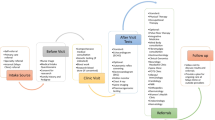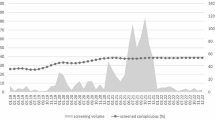Abstract
Patients diagnosed with von Hippel-Lindau disease (vHL) require life-long surveillance for this multi-system disease. It is therefore important to assess the comprehensiveness of screening provision, as well as identify what type of screening service is most likely to encourage regular patient attendance. This descriptive study reports on two types of screening service: single appointment One Stop (OS) clinics and multiple appointment Ad Hoc (AH) clinics. One hundred and seventeen vHL patients from eight regional genetics centres were approached to take part. Seventy-two (61.5%) returning a completed study questionnaire: fifty-four (75%) were screened at OS clinics and eighteen (25%) at AH clinics. Comprehensiveness of screening, attendance rates, patient ratings of quality of care and levels of psychological morbidity were compared between the two types of service. While levels of disease severity were similar in patients screened at OS and AH clinics, those seen at OS clinics were screened for twice as many site-specific vHL manifestations compared to those seen at AH clinics (P < 0.0001). More patients at OS clinics regularly attended their screening appointments compared to those at AH clinics (P = 0.0045). There was no difference in the quality of care reported by patients attending the two types of screening service and few problems were reported. Twenty-nine percent of respondents were categorised as clinically anxious and 13% as clinically depressed. These findings suggest that an optimum vHL screening service is one based on OS clinics offering regular comprehensive surveillance and psychological support.
Similar content being viewed by others
Abbreviations
- vHL:
-
von Hippel-Lindau disease
- OS:
-
One Stop
- AH:
-
Ad Hoc
References
Maher ER, Iselius L, Yates JR et al (1991) Von Hippel-Lindau disease: a genetic study. J Med Genet 28:443–447
Latif F, Tory K, Gnarra J et al (1993) Identification of the von Hippel-Lindau disease tumor suppressor gene. Science 26:1317–1320
Evans DG, Maher ER, Macleod R et al (1997) Uptake of genetic testing for cancer predisposition. J Med Genet 34:746–748
Glasker S (2005) Central nervous system manifestations in VHL: genetics, pathology and clinical phenotypic features. Fam Cancer 4(1):37–42
Kreusel KM (2005) Ophthalmological manifestations in VHL and NF 1: pathological and diagnostic implications. Fam Cancer 4(1):43–47
Kreusel KM, Bechrakis NE, Heinichen T et al (2000) Retinal angiomatosis and von Hippel-Lindau disease. Graefes Arch Clin Exp Ophthalmol 238(11):916–921
Maher ER, Yates JR, Harries R et al (1990) Clinical features and natural history of von Hippel-Lindau disease. Quart J Med 77:1151–1163
Maranchie JK, Afonso A, Albert PS et al (2004) Solid renal tumor severity in von Hippel Lindau disease is related to germline deletion length and location. Hum Mutat 23(1):40–46
Opocher G, Conton P, Schiavi F et al (2005) Pheochromocytoma in von Hippel-Lindau disease and neurofibromatosis type 1. Fam Cancer 4(1):13–16
Lonser RR, Glenn GM, Walther M et al (2003) von Hippel-Lindau disease. Lancet 361(9374):2059–2067
Foulkes WD, Hodgson SV (1998) Inherited susceptibility to cancer: clinical, predictive, and ethical perspectives. New York: Cambridge University Press
Marteau T (1993) Health-related screening: psychological predictors of uptake and impact. In: Maes S, Leventhal H, Johnston M (eds) International review of health psychology. John Wiley & Sons Ltd, pp 149–174
Jenson CE (1993) Von Hippel-Lindau: a relentless disorder. RN 56(8):36–40
Nash TL (1994) Von Hippel-Lindau shouldn’t stand in the way of goals. RN 57:10
Levy M, Richard S (2000) Attitudes of von Hippel-Lindau disease patients towards presymptomatic genetic diagnosis in children and prenatal diagnosis. J Med Genet 37(6):476–478
Rimes KA, Salkovskis PM (2002) Prediction of psychological reactions to bone density screening for osteoporosis using a cognitive-behavioral model of health anxiety. Behav Res Ther 40:359–381
Naik R, Abang-Mohammed K, Tjalma WA et al (2001) The feasibility of a one-stop colposcopy clinic in the management of women with low grade smear abnormalities: a prospective study. Eur J Obstet Gynecol Reprod Biol 98:205–208
Abu JI, Habiba MA, Baker R et al (2001) Quantitative and qualitative assessment of women’s experience of a one-stop menstrual clinic in comparison with traditional gynaecology clinics. BJOG 108:993–999
Dey P, Bundred N, Gibbs A et al (2002) Costs and benefits of a one stop clinic compared with a dedicated breast clinic: randomised controlled trial. BMJ 324:507
Sharma M, Taylor A, Al Khouri A et al (2002) Management of infertility: one stop clinic may offer solution. BMJ 325(7372):1116
Hudak PL, Wright JG (2000) The characteristics of patient satisfaction measures. Spine 25:167–177
Young GJ, Meterko M, Desai KR (2000) Patient satisfaction with hospital care: effects of demographic and institutional characteristics. Med Care 38:325–334
Schers H, Webster S, van den Hoogen HH et al (2002) Continuity of care in general practice: a survey of patients’ views. Br J Gen Pract 52:459–462
Sweeney KG, Gray DP (1995) Patients who do not receive continuity of care from their general practitioner—are they a vulnerable group? Br J Gen Pract 45:133–135
Shepperd S, Richards S (2002) Continuity of care—a chameleon concept. J Health Serv Res Policy 7:130–132
Marteau TM, Bekker H (1992) The development of a six-item short-form of the state scale of the Spielberger State-Trait Anxiety Inventory (STAI). Br J Clin Psychol 31 (Pt 3):301–306
Zigmond AS, Snaith RP (1983) The hospital anxiety and depression scale. Acta Psychiatr Scand 67:361–370
Lerman C, Trock B, Rimer BK et al (1991) Psychological side effects of breast cancer screening. Health Psychol 10:259–267
Lerman C, Trock B, Rimer BK et al (1991) Psychological and behavioral implications of abnormal mammograms. Ann Intern Med 114:657–661
Borowsky SJ, Nelson DB, Fortney JC et al (2002) VA community-based outpatient clinics: performance measures based on patient perceptions of care. Med Care 40:578–586
Hay JL, Buckley TR, Ostroff JS (2005) The role of cancer worry in cancer screening: a theoretical and empirical review of the literature. Psycho-Oncology 14(7):517–534
Darr A (1999) Access to genetic services by minority ethnic populations: a pilot study. [cited 2006 05 October 2006]; Project Report. Available from: http://www.gig.org.uk/docs/gig_access.pdf
Mehta P (2005) Promoting equity of access to genetic healthcare: a guide to the development of linguistically and culturally competent communication services. [cited 2006 5 October 2006]; Project Report. Available from: http://www.gig.org.uk/docs/promotingaccess.pdf
Murray-Garcia JL, Selby JV, Schmittdiel J et al (2000) Racial and ethnic differences in a patient survey: patients’ values, ratings, and reports regarding physician primary care performance in a large health maintenance organization. Med Care 38(3):300–310
Sitzia J, Wood N (1997) Patient satisfaction: a review of issues and concepts. Soc Sci Med 45(12):1829–1843
Hargraves JL, Wilson IB, Zaslavsky A et al (2001) Adjusting for patient characteristics when analyzing reports from patients about hospital care. Med Care 39(6):635–641
Ren XS, Kazis L, Lee A et al (2001) Health status and satisfaction with health care: a longitudinal study among patients served by the Veterans Health Administration. Am J Med Qual 16(5):166–173
Dixon JM (2002) One stop clinics should not be abandoned. BMJ 324(7336):507
Shuin T, Yamazaki I, Tamura K et al (2004) Recent advances in ideas on the molecular pathology and clinical aspects of Von Hippel-Lindau disease. Int J Clin Oncol 9(4):283–287
Acknowledgements
We would like to acknowledge the support received from members of the Steering Committee for the British Family Cancer Record (John Burn, Tim Bishop, Eamonn Sheridan, Lauren Padmore, Peter Sasieni, Huw Thomas, Gwen Turner, Richard Turner, Robin Waxman); the consultants (Anneke Lucassen, Fiona Douglas, Fiona Lalloo, Joan Paterson, Sozia Miedzybrodzka) and genetics counsellors (Gillian Crawford, Peter Risby, Carol Giblin, Helen Burton, Sheila Goff, Deborah Leatham) at participating centres; and Teresa Mielniczek for help in collating the data. Without their help this study would not have been possible. This work was supported by grants from Cancer Research UK and the National Lottery Charities Board.
Author information
Authors and Affiliations
Corresponding author
Appendix
Appendix
Rights and permissions
About this article
Cite this article
Fraser, L., Watts, S., Cargill, A. et al. Study comparing two types of screening provision for people with von Hippel-Lindau disease. Familial Cancer 6, 103–111 (2007). https://doi.org/10.1007/s10689-006-9111-y
Received:
Accepted:
Published:
Issue Date:
DOI: https://doi.org/10.1007/s10689-006-9111-y




